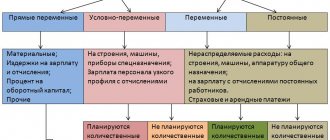Setting up personal income tax accounting
Setting up registration with the tax authority
This is the most important setting; without it, you will not be able to submit reports to regulatory authorities. Let's go to the "Organizations" directory (menu "Main" - "Organizations"). Having selected the desired organization, click the “More...” button. From the drop-down list, select “Registration with tax authorities”:
You must carefully fill out all the details.
Setting up payroll accounting
These settings are made in the “Salary and Personnel” section – “Salary Settings”.
Let’s go to “General Settings” and indicate that accounting is maintained in our program, and not in an external one, otherwise all sections related to personnel and salary accounting will not be available:
Next, click on the link “Salary Accounting Procedure”.
In the window that opens, click on the link “Set up reports and taxes”:
On the “Personal Income Tax” tab, you need to indicate in what order standard deductions are applied:
On the “Insurance Premiums” tab, you need to indicate at what rate insurance premiums are calculated:
Any accruals to individuals are made according to the income code. For this purpose, the program has a reference book “Types of personal income tax”. To view and, if necessary, adjust the reference book, you need to return to the “Salary Settings” window. Let’s expand the “Classifiers” section and click on the “NDFL” link:
The personal income tax calculation parameters settings window will open. The reference book is located on the corresponding tab:
To set up personal income tax taxation for each type of accrual and deduction, you need to expand the “Salary calculation” section in the “Salary settings” window:
In most cases, these settings are enough to start accounting for salaries and personal income tax. I will only note that the directories can be updated when the program configuration is updated, depending on changes in legislation.
Calculation of personal income tax on travel expenses
Travel expenses in terms of daily allowance and unconfirmed costs for renting residential premises, in accordance with clause 3 of Art. 217 of the Tax Code of the Russian Federation are standardized for personal income tax purposes. Daily allowances in excess of the norm and expenses for renting residential premises that are not documented are subject to personal income tax at a rate of 13%.
The norms for daily allowance are set within the following limits: for business trips in Russia - no more than 700 rubles. per day, for business trips abroad - no more than 2,500 rubles. in a day.
Read about similar restrictions that apply to daily allowances regarding the calculation of insurance premiums in this article.
When an organization pays daily allowance to an employee by internal order above the established norm, the following entries are made:
Dt 71 "F. Acting employee" Kt 50 (51) - an advance was issued to the accountable person for travel expenses.
Dt 44 (20, 26) Kt 71 “F. Acting employee”—travel expenses are accrued.
Dt 70 "F. Acting employee" Kt 68 "Personal Income Tax" - personal income tax is charged on amounts for business trips that exceed the norm. The date of receipt of such income from 2021 is considered to be the last day of the month in which the corresponding advance report was approved (subclause 6, clause 1, article 223 of the Tax Code of the Russian Federation). Previously, it was taken into account on the date of approval of the advance report.
Dt 68 “NDFL” Kt 51 - paid by personal income tax to the budget.
Personal income tax accounting in 1C: accrual and deduction
Personal income tax is calculated for each amount of income actually received separately for the period (month).
The amount of personal income tax is calculated and accrued using documents such as “Payroll”, “Vacation”, “Sick leave” and so on.
As an example, let’s take the “Payroll” document:
On the “Personal Income Tax” tab we see the calculated tax amount. After posting the document, the following personal income tax transactions are created:
The document also creates entries in the “Accounting for Income for Calculating Personal Income Tax” register, according to which reporting forms are subsequently filled out:
In fact, the tax withheld from the employee is reflected in the accounting when posting documents:
- Cash withdrawal;
- Debiting from the current account;
- Personal income tax accounting operation.
Unlike accrual, the tax withholding date is the date of the posted document.
Separately, you should consider the document “Personal Income Tax Accounting Operation”. It is provided for calculating personal income tax on dividends, vacation pay and other material benefits.
The document is created in the “Salaries and Personnel” menu in the “Personal Income Tax” section, link “All documents on personal income tax”. In the window with a list of documents, when you click the “Create” button, a drop-down list appears:
Almost all documents that in one way or another affect personal income tax create entries in the register “Calculations of taxpayers with the budget for personal income tax.”
As an example, let’s consider the formation of tax accounting register entries using the document “Write-off from current account.”
Let’s add the document “Statement to the Bank” (menu “Salaries and Personnel” - link “Statements to the Bank”) and based on it we will create a “Write-off from the current account”:
After this, let’s look at the postings and movements in the registers that the document generated:
The procedure for calculating personal income tax on material benefits (example)
When receiving a low-interest or interest-free loan from an organization, the employee receives a material benefit in terms of savings on interest.
IMPORTANT! From 2021, new conditions for personal income tax assessment of this type of financial benefit have been introduced. See more details.
It matters in what currency the loan agreement is drawn up.
If it is issued in rubles, then the threshold rate is 2/3 of the current refinancing rate established by the Central Bank of the Russian Federation on the date of receipt of income (clause 2 of Article 212 of the Tax Code of the Russian Federation).
IMPORTANT! From 2021, the refinancing rate is equal to the key rate (directive of the Central Bank of the Russian Federation dated December 11, 2015 No. 3894-U). For its dimensions for different periods, see.
If the loan is issued in foreign currency, then the established threshold value is 9% per annum (clause 2 of Article 212 of the Tax Code of the Russian Federation).
If interest is less than the threshold values or is not charged at all, personal income tax is withheld from the difference at a rate of 35%.
It is better to consider the postings for calculating personal income tax using a specific example.
The organization issued a loan to employee Ivanov I.I. (resident of the Russian Federation) for a period of 1 year in rubles at a rate of 3% per annum with interest paid at the end of the loan term. Loan size - 500,000 rubles.
Dt 73 “Ivanov I. I.” Kt 50 - 500,000 rub. — the loan amount was issued to Ivanov on January 15, 2020.
Income from the amount of the benefit from 2021, regardless of the date of payment of interest, is determined monthly on the last day of the month. Let's calculate the amount of interest on the loan for January 2021. There was no partial repayment of the loan in January. The number of days for which material benefits are calculated from 01/16/2020 to 01/31/2020 is 16.
500,000 × 0.03 × 16/365 = 657.53 rubles.
Dt 73 “Ivanov I. I.” Kt 91 - 657.53 rub. — interest accrued for using the loan for January 2021.
Let's calculate personal income tax on the amount of material benefit (at a Central Bank rate of 6.25%).
2/3 × 6.25% = 4.17% - threshold, taking into account the current refinancing rate.
4.17 – 3 = 1.17% - interest on material benefits.
500,000 × 0.0117 × 16 / 365 = 256.44 rubles. - material benefit for January 2021. Let's calculate personal income tax (35%) from it: 256.44 × 0.35 = 90 rubles.
If Ivanov were a non-resident of the Russian Federation, then the tax would be withheld at a rate of 30% (clause 3 of Article 224 of the Tax Code of the Russian Federation).
Dt 70 (73) “Ivanov I. I.” Kt 68 “NDFL” - 166 rubles. — Personal income tax on material benefits for January 2021 is withheld from the employee’s salary (or other income).
Dt 68 “NDFL” Kt 51 - 166 rubles. — Personal income tax from savings on interest for January 2021 is transferred to the budget.
Is it necessary to charge personal income tax if a third party paid the tax for an individual, ConsultantPlus experts explained. Learn the material by getting trial access to the system for free.
Formation of personal income tax reporting
Above, I described the main registers that are involved in the generation of basic personal income tax reports, namely:
- Certificate 2-NDFL (for employees and the Federal Tax Service). Formed in the “Personal Income Tax” section, “Salaries and Personnel” menu:
In the window with a list of documents, click the create button and fill out the employee certificate:
The document does not generate transactions and entries in registers, but is only used for printing.
- 6-NDFL data (section 2):
The report relates to regulated reporting. You can also proceed to its registration from the “Personal Income Tax” section, the “Salaries and Personnel” menu, or through the “Reports” menu, the “1C Reporting” section, “Regulated Reports”.
An example of filling out the second section:
Account 68 in accounting
Account 68 is credited for amounts according to tax returns or calculations in correspondence:
- Account 99 - for the amount of accrued income tax;
- Invoice 70 - for the amount of personal income tax;
- Accounts 20, 25, 26, 44 - for the amount of local taxes, transport tax, property tax, etc.;
- Accounts 90.3, 91.2, 76.AV - when calculating VAT for the reporting quarter;
- Invoice 51 - upon receipt of overpaid tax from the budget.
The debit of the account records the amounts of taxes actually transferred to the budget, including the amounts of VAT written off from account 19.
Subaccounts under account 68 are used for taxes and fees paid by the company, depending on its chosen field of activity and tax regime. In this case, a separate sub-account is opened for each type of tax:
Additional sub-accounts can also be opened under account 68:
- 68.11 - UTII;
- 68.12 – simplified tax system;
- 68.13 – Trade fee.
Detailed analysis of personal income tax for an employee in 1C Salary and personnel management 8
Content:
1. Analysis of personal income tax for an employee in 1C
2. Report “Detailed analysis of personal income tax for employees” in 1C.
3. Application of the report in 1C Salary and Personnel Management 8
1. Analysis of personal income tax for an employee in 1C
When calculating salaries and calculating taxes, sometimes it is necessary to prepare a lot of documents, adjustments, and payments. The correctness of salary and tax calculations in 1C depends on the correctness and preservation of the methodological consistency.
Most often, mistakes made in 1C salary calculations and taxes are immediately visible. The main difficulties arise when withholding and transferring personal income tax, as well as when distributing the withheld and transferred tax among separate divisions and upon registration with the tax authority.
Due to the heavy workload on accounting employees, the issue of correct calculation of personal income tax in 1C begins to be dealt with when an employee is dismissed or reports are submitted for 2-NDFL and 6-NDFL.
In such cases, it becomes necessary to conduct an analysis of personal income tax.
Report “Detailed analysis of personal income tax for employees” in 1C
The simplest tool for analyzing errors is the report “Detailed analysis of personal income tax for an employee”, in 1C: “Taxes and contributions → Reports on taxes and contributions.”
The most common errors when calculating personal income tax occur in salary payment documents:
· Cash register statement;
· Statement to the bank;
· Statement of accounts;
· Statement through the distributor.
This error occurs when processing payment documents “retrospectively” or in the case when a previously created document is carried out after registering a later payment.
Using the report in 1C Salary and Personnel Management 8
The tax that is withheld and transferred is reflected in reports when posting payment documents. In practice, tax reporting is sometimes incorrect.
As can be seen in the example above, errors and their causes are immediately detected. The report uses all necessary registers:
When trying to analyze most reports, there may be certain difficulties in understanding how the report fields are filled in in 1C. In this sense, “Detailed analysis of personal income tax for employees” is distinguished by its clarity and simplicity.
An error that occurs when calculating, withholding and transferring personal income tax is easiest to eliminate by restoring the methodological sequence of the document and/or using the “Update tax” function in the payment statement.
Most often, this is enough to eliminate an error in tax withholding and remittance.
In more complex cases, personal income tax should be adjusted in accrual documents.
If an error in tax calculation occurred in the current period, the most correct thing to do would be to recalculate the accruals for the employee in question. After this, re-make the corresponding payments and be sure to update the tax in this payment.
If an error was identified in the previous period, then several options for making adjustments are possible:
· Correction of the accrual document;
· Adjustment of payment or additional accrual in the payroll document;
· Additional accrual, recalculation in a separate document, if this option is activated.
Attention:
· It is imperative to check the correctness of accrual and deduction for specific employees when paying vacation pay, as well as when dismissing an employee.
· regularly checking personal income tax calculations is also important for the reason that filling out the 6-personal income tax report depends on it;
· to prevent errors, it is not recommended to create payment documents by copying earlier payment documents;
· if you make changes to any documents, do not forget that re-registration and re-registration of all later documents is required;
· It is not recommended to make changes to the documents of the previous reporting period (if changes need to be made specifically in an earlier reporting period, it is necessary to check all tax reports and, if they are changed, submit corrective reports.
In the considered example, the standard setting of 1C Salary and Personnel Management 8 was used.
If for some reason the report stops being generated, you should restore the standard report settings.
Specialist
Poruss Irin Yurievna









